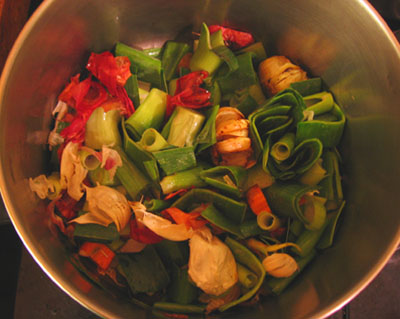It has been really cold here. Really cold. And it’s not just me being a thin-blooded California wimp, either. It snowed in the Berkeley Hills a couple of days ago. Snow!
I know, I know. “Boo hoo, cry me a river,” you’re probably shivering at me from the middle of a Minnesota winter. We are spoiled here – even when it’s winter, it’s summer. Or something like that.
Nothing exemplifies a Bay Area winter meal more than what we had for dinner tonight: California Minestrone and Salade Nicoise. Lots of tummy warming goodness from the soup and stick-to-your-ribs heartiness from the potatoes in the salad, but the crazy thing is that it’s December and every single element of these two veggie-intensive meals came straight out of our CSA box. (Except for a couple things in the salad: olives – left over from Thanksgiving – and tomatoes – doubtlessly hothouse.)
I’ve been wanting to make California Minestrone ever since the weather started getting nippy. The recipe is from the fantastic cookbook Spa Food by Edward J. Safdie, chef of the venerable Sonoma Mission Inn. The plating and food design are entirely 80s (the cookbook was published in 1985) but the recipes for healthy, satisfying, sophisticated food featuring California flavors are timeless. I grew up eating from this cookbook (my mom and I have made nearly every recipe in it) and this soup in particular invokes for me both the chill and the bounty of a Bay Area winter.
I was lacking only a leek and some cabbage to make the soup (I often skip the green beans and spinach for my winter version), and when I opened our box today, there they were. Here’s the complete record of what came in today’s size “small” box:
Satsuma Mandarins (2 lb)
Bartlett Pears (1.5 lb)
Savoy Cabbage (2 lb)
Collard Greens (1 bunch)
Baby Bok Choy (1.5 lb)
Broccoli (1 lb)
Red Onions (0.5 lb)
Leeks (1 lb)
Yellow Onion (0.5 lb)
California Minestrone (from Spa Food by Edward J. Safdie)
This is a light but filling soup that can be made with a variety of vegetables, but I think the leek, carrot, cabbage, and tomatoes (I used canned whole tomatoes) are essential for giving it sweetness, acid, and depth. Serve it with a crusty loaf of rustic bread if you eat bread and with a hearty sprinkling of Parmesan cheese on top if you eat dairy.
1 T. unsalted butter or Earth Balance
1/2 an onion, cut into 1/2 inch dice
1 leek (white part only), washed and cut into 1/4 inch slices
1 carrot, cut into 1/4 inch slices
1 celery stalk, cut into 1/4 inch slices
1 garlic clove, minced
3-4 canned plum tomatoes, drained or 2 unpeeled tomatoes, seeded and chopped
6 cabbage leaves, coarsely chopped
6 oz. fresh green beans, ends trimmed and cut on a slant into 1/2 inch pieces
2 quarts stock (I used our latest batch of scrap stock)
10 spinach leaves, washed, drained, and coarsely chopped
Freshly ground pepper to taste
Salt or vegetable seasoning to taste
1 t. pesto (I usually use more like 1-3 T. vegan pesto, which is often pretty mild)
1/4 C. grated Asiago or Parmesan cheese
In a 4-quart pot, melt the butter over medium heat. Add the onion, leek, carrot, celery, garlic, tomatoes, cabbage, and green beans, and saute over medium heat for 3-5 minutes, stirring often.
Add the stock and bring to a boil. Lower the heat and simmer, uncovered, for 25 minutes.
Add the spinach and simmer for 5 more minutes. Remove the pot from heat and stir in the pesto. Taste the finished soup and adjust the seasonings.
Serve in large heated soup bowls and sprinkle with 1 T. grated cheese over each portion.
If you follow the recipe exactly, this will make 4 servings, at 150 calories per serving.









